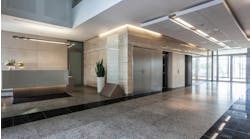The ideal entryway in a building will have a flooring system that adequately protects occupants from injury and the rest of the building from outdoor elements that find their way inside. These measures can ensure that you are doing both.
Slips and Falls with Floor Mats
Providing the right flooring solutions in your entryway is vital because it facilitates the transition from outside the building to the inside, which becomes even more critical when weather is a factor. Providing the right materials for the entrance will keep your building safer and cleaner.
“The key is to focus on the walkway surface that people encounter when they first come into a building. That’s really important when preventing slips and falls,” says Russell Kendzior, President and Chairman of the National Floor Safety Institute (NFSI). “A lot of businesses will simply use entryway floor mats, which are great if you use the right type and the right size. The problem is that those mats, although designed to prevent slips and falls, then create trips and falls.”
The greatest threat to floor mats working effectively is moisture. Once they become saturated, they not only allow water to be more easily tracked into the rest of the building, but they also pose a new, often unexpected threat to people entering.
“Once the water gets on the floor or under the mat, it becomes a surfboard. Somebody walks in from outside, steps on the mat and it flies under their feet. The mat induced the slip and fall,” explains Kendzior. “We don’t recommend vinyl-backed mats because they have a very low water retention ability. They also have a very poor level of slip resistance for their backings. We recommend that floor mats being selected have the appropriate backing – one that’s NFSI-certified as high-traction.”
Mats with high-traction backing and the ability to absorb high levels of moisture without becoming saturated will be able to withstand more water than lower quality options, but even the best mats – when saturated – are ineffective and will bring water and materials from outside into the building while also presenting safety hazards.
“When that floor mat gets saturated, remove it from service promptly,” says Kendzior. “One of the biggest headaches is that floor mats get saturated, and when people walk from the mat onto the floor, they take that water with them on their shoes. Now you have a wet floor, and people slip and fall.”
Other Options and Measures
Types of Entryway Mats
- Wiper mats: Mats designed to remove moisture, contaminants, dust and finer soil from footwear.
- Wiper-scraper mats: Mats designed to remove and retain finer soil, dust and absorb some moisture and contaminants from footwear.
- Scraper mats: Mats that remove and retain heavier and larger soil through contact with footwear.
- Recessed well mats: Also referred to as a foot grille, recessed well mats are installed in a well below the surrounding floor level. They can also be installed on the surface with permanent frames and ramps. The mat construction can be either as a scraper mat or a wiper-scraper mat.
- Mat tiles: Tiles constructed of heavy denier fibers that are either tufted or needle punched or made from recycled tires. Sometimes these products have a hi-low construction.
- Heavy-duty needle punch matting: Thick matting manufactured in a needle punch process from large fibers, usually with a latex backing. This matting is finished with applied edging.
ANSI/NFSI B101.6-2012
Floor mats aren’t the only option for an entrance. They require more oversight and care, and for those in buildings that have larger entrances or higher traffic than floor mats can withstand, there are better solutions available.
According to Kendzior, walk-off carpet tiles can provide a heavy duty option that will more effectively mitigate the transfer of moisture and outdoor materials inside. However, unlike a traditional mat, walk-off carpet typically requires a change in flooring at the entrance. Nevertheless, they can reduce maintenance and injury risk.
“Walk-off mats remove most contaminants that would otherwise be tracked into buildings,” explains the Minnesota Department of Health. “Proper maintenance will ensure they are effective at preventing these contaminants from being deposited in rooms. Sand and grit can also damage flooring, making these surfaces harder to clean.”
Another measure to better safeguard your flooring inside is to address outdoor conditions. Winter is a particularly troublesome time because of the quantity of snow and water that will migrate into the building, so providing your building with a first line of defense outside can save the interior flooring.
“Some facilities employ the use of scraper mats, and they can be very effective based on the specific type and size of the scraper or rubber mat that you’re using,” says Kendzior. “If you’re going to use a mat outside of your building to have people knock some of the soil or snow off of their shoes, using a large, rubber scraper mat is a great way to do it. By the time they come into the building, snow that was on their boots or shoes is not being tracked in.”
Of course, addressing walkways and other surfaces where building occupants might pick up snow, ice and soil will also help. Having a proactive response to winter weather will reduce the amount of water and material that occupants’ shoes will pick up on their way to the building. Moreover, Kendzior suggests using deicer before it snows so it can effectively reduce snow and ice buildup before it becomes a problem.
For more information about entryway flooring options, visit www.nfsi.org.
Justin Feit [email protected] is an assistant editor of BUILDINGS.


